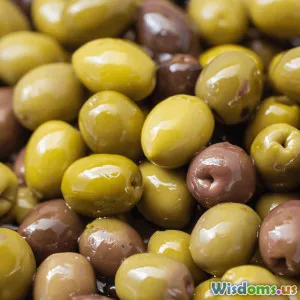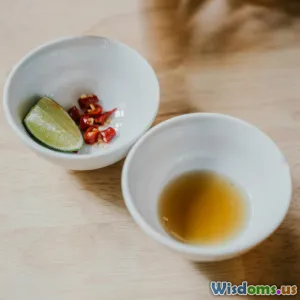
Debunking Five Common Myths About Olive Oil
9 min read Uncover the truth behind olive oil myths and learn facts that elevate your cooking and health choices. (0 Reviews)
Debunking Five Common Myths About Olive Oil
Olive oil has long been celebrated as a cornerstone of healthy eating, heralded for its heart-healthy fats and rich flavors. Yet, despite its popularity, olive oil is surrounded by a fog of misinformation. From doubts about its cooking temperature to confusion over types and benefits, these myths can obscure the truth and even lead to poor culinary decisions. Let’s carve through the myths and discover the facts unlocking olive oil’s full potential.
Myth 1: Olive Oil Is Bad for Cooking at High Heat
One of the most pervasive myths is that olive oil is unsuitable for cooking because it smokes and burns easily. The assumption is that its so-called "low smoke point" ruins its flavor and produces harmful compounds.
The Truth About Smoke Points
Extra virgin olive oil typically smokes between 375°F to 410°F (190°C to 210°C), which is comparable to much cooking fats like butter and other vegetable oils. In practical kitchen terms, this means it can safely handle most typical frying and sautéing tasks.
Food scientist Harold McGee states in "On Food and Cooking" that refined olive oil actually boasts even higher smoke points, around 465°F (240°C). Moreover, the antioxidants in extra virgin olive oil (EVOO) increase its thermal stability. It’s only in extreme conditions, like high-temperature deep-frying or prolonged heating, where issues may arise.
Cooking with Olive Oil in Practice
Professional chefs around the Mediterranean use EVOO for sautéing, roasting, and even grilling, relying on its resilience and flavor. For example, renowned chef José Andrés highlights that "High-quality olive oil not only survives cooking but enhances the dish’s flavor profile."
Takeaway: Using good-quality olive oil for medium to medium-high heat cooking is safe, flavorful, and healthy. Avoid burning it by controlling heat and discarding oil that smokes persistently.
Myth 2: Light or “Pure” Olive Oil Is Superior for Health
In many supermarkets, "light" or "pure" olive oil suggests a healthier or lighter option. This is misleading marketing - these labels do not refer to calories but to the oil’s color or refined nature.
Differences Between Olive Oil Types
- Extra Virgin Olive Oil (EVOO): Cold-pressed, unrefined, retains maximum antioxidants and flavor.
- Virgin Olive Oil: Also cold-pressed but with slightly more acidity and lower antioxidant content.
- Refined (Pure or Light) Olive Oil: Processed with heat and chemicals, stripping its flavor and much of its nutrient value.
Research published in the "International Journal of Molecular Sciences" documents that polyphenols, the antioxidants responsible for many of olive oil’s health benefits, diminish significantly after refining.
Health Implications
Consuming EVOO regularly is linked to lower risks of cardiovascular disease, improved cholesterol balance, and anti-inflammatory effects. Refined oils lack these protective compounds.
Example: The Mediterranean diet study showed health improvements primarily attributed to high EVOO intake, not refined versions.
Takeaway: Choose extra virgin olive oil to maximize health benefits. Labels like “light” or “pure” refer to refinement level, not calorie count or health superiority.
Myth 3: Olive Oil and Butter Are Equally Healthy
While olive oil is often touted as a healthy alternative to butter, it’s essential to understand their differences, nutritionally and structurally.
Fat Composition Comparison
Olive oil is rich in monounsaturated fats (about 73%), particularly oleic acid, renowned for reducing LDL (bad cholesterol) and increasing HDL (good cholesterol). Butter contains about 51% saturated fats, which studies correlate with increased cardiovascular risk when consumed excessively.
A 2017 meta-analysis from the "American Journal of Clinical Nutrition" demonstrated that replacing saturated fats with monounsaturated fats like those in olive oil reduces heart disease risk.
Culinary and Health Contexts
Butter provides desirable flavors and textures but should be limited for health reasons. Olive oil offers both taste and healthfulness.
Quote: Dr. Walter Willett, a leading nutrition researcher, states, "Replacing saturated fats with unsaturated fats, particularly from sources like olive oil, is a powerful strategy to improve heart health."
Takeaway: Olive oil is healthier than butter when used as a primary fat, but moderation and balanced diet remain crucial.
Myth 4: All Extra Virgin Olive Oil Is Equal
Not all EVOO is created equal—quality varies enormously, affecting flavor, health benefits, and authenticity.
Factors Impacting Quality
- Harvesting: Olives must be harvested at optimal ripeness and processed quickly to prevent oxidation.
- Processing: Cold-pressing and minimal filtration preserve delicate compounds.
- Storage: Exposure to light, heat, and oxygen deteriorates oil quality rapidly.
The Problem of Fraud
Up to 69% of olive oil labeled as "extra virgin" in some markets failed sensory or chemical standards according to a 2010 UC Davis study. Common adulterants include cheaper oils like soybean or lower grade olive oil.
Detecting Real EVOO
High-quality EVOO will have a fresh, peppery, grassy, or fruity aroma, and sometimes a slight bitterness or pungency—signs of antioxidants.
Example: The International Olive Council provides strict guidelines to verify quality, encouraging consumers to look for certification seals.
Takeaway: Browse carefully, buy from trusted producers, and value freshness. Price and certifications are useful quality indicators.
Myth 5: Olive Oil Doesn't Go Bad
Some people assume olive oil is shelf-stable indefinitely, yet it certainly can degrade, losing flavor and nutritional strength over time.
How Olive Oil Goes Bad
Exposure to oxygen, heat, and light triggers oxidation leading to rancidity. Rancid oil smells sour, stale, or musty and should not be consumed.
Industry experts recommend:
- Storing olive oil in a cool, dark place.
- Using within 12-18 months of pressing.
- Using smaller bottles to reduce oxygen exposure.
Signs and Implications
While rancidity isn't acutely toxic, consuming stale olive oil offers no health benefit and can contribute to undesirable flavors.
Takeaway: Treat olive oil like fresh produce—store properly and check for freshness regularly.
Conclusion: Embrace Olive Oil Wisely
Understanding these common myths empowers you to enjoy olive oil to its fullest. It’s a versatile, health-promoting fat, provided that you choose genuine extra virgin types, use it properly in cooking, and store it carefully. Navigate beyond the rumors, invest in quality, and savor the rich heritage and well-earned accolades olive oil rightfully deserves. After all, wise kitchen choices nourish both body and soul.
References
- Harold McGee, "On Food and Cooking: The Science and Lore of the Kitchen"
- "International Journal of Molecular Sciences," Polyphenols in Olive Oil
- "American Journal of Clinical Nutrition," 2017 meta-analysis on fats
- UC Davis Olive Center Reports
- Statements from Dr. Walter Willett and Chef José Andrés
This knowledge offers you a firmer grip on olive oil's truth, making each drizzle healthier and every dish more flavorful.
Rate the Post
User Reviews
Popular Posts




















